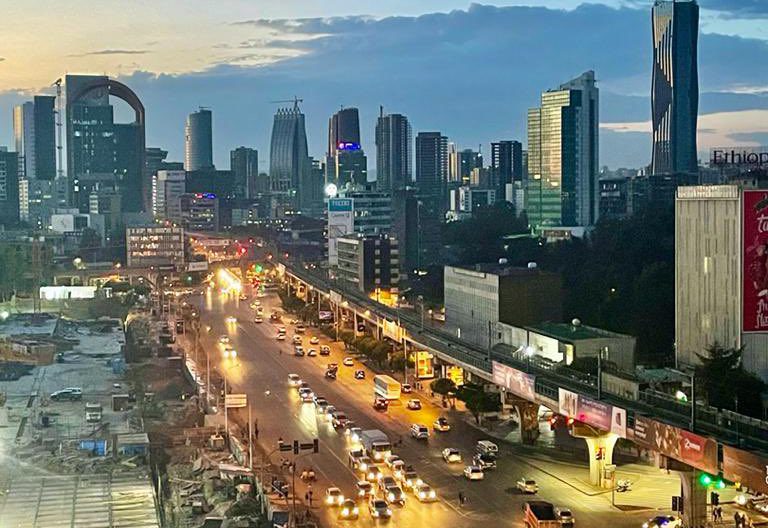
JOSEPH SOBOKA
Addis Ababa is the metropolis city of Ethiopia located on a well-watered plateau surrounded by hills and mountains in the heart of the country. With her pleasant climate, never too hot or too cold, she is just a very suitable area for life. The city could have been constructed on Entoto had it not been for its extreme cold and an acute shortage of firewood.
According to history, Addis Ababa came into existence in 1886 as a mineral springs resort for Ethiopia’s royal family and nobility. In 1892, Emperor Menilek II (1889-1913) made it the capital when he constructed his palace there. By 1896, members of the nobility began to build permanent homes in the new capital. At present the 135 years old city has gone through series of dramatic transformations to raise her structural and aesthetic value to compete with many African cities in size and modernity.
The many roads and parks developed as of late, have greatly contributed to her relatively astounding beauty. Yet, the transformation is still vigorously in progress. Initiated by the Prime Minister Dr. Abiy Ahmed, the parks are meticulously designed for public recreation and thus they have become the focal point in raising the aesthetic standard of Addis Ababa to a higher level. The parks include, Unity Park, Friendship Park and Shegger Park. Unity Park has absolutely transformed the image of the Grand Palace and at the same time carries the sentiment of oneness of the Ethiopian people through the representation of their cultural assets in it.
Whether it is on top of Entoto or at Aratkilo, the areas that were once lay waste are now beautified by flowers, trees and structures of various forms forcing visitors or passersby gaze at them in admiration. Obviously, these parks, sooner or later can make Addis Ababa a tourist destination for local and international visitors. The other fascinating thing is the innovation of the Meskel Square and the construction of immense underground park for vehicles the first of its kind in Ethiopia, perhaps in africa.
According to the statistic, the current metro area population of Addis Ababa in 2021 is 5,006,000, a 4.42% increase from 2020. The metro area population of Addis Ababa in 2020 was 4,794,000, a 4.4% increase from 2019. The metro area population of Addis Ababa in 2019 was 4,592,000, a 4.36% increase from 2018. The fast rise of the population to a major degree is attributed to the influx of people into the city from other parts of the country looking for better opportunities of various natures. Being as large as 527 km², Addis still stretches out to the surrounding areas for the construction of residences. With her present size she still finds it difficult to accommodate all the city dwellers.
Major roads in Addis Ababa include Churchill Avenue, Meskel Street, Bole Road, to mention a few. Addis Ababa – Adama Expressway the new six-lane and 12m-wide road was constructed along a different route. The toll road reduces the travel time to around 40 minutes from the average two hours between Addis and Adama.
The City Administration of Addis Ababa, as of late, has widened the Churchill Avenue to give vehicles ample space for comfortable driving and reduction of traffic accident and thereby add beauty to the avenue.
Addis Ababa, Ethiopia’s capital, which is translated as “New Flower” in Amharic language, shows little sign of losing its youthful, lusty edge. It is the pulsing heart of the nation. It is eclectic or that draws methods that a city requires for development. Currently, Addis is noted for her ever reviving state as one of Africa’s fastest-growing cities. Constructing attractive fences around buildings and painting them with beautiful colors is the order of the day and it has made the city a more relaxing place to living in. The newly high-rising buildings at different parts of the city are worth commending.
“Addis,” as it’s often simply known, is the world’s third-highest capital city at 2,400 meters. Life is lived very much outdoors on its bustling streets thanks to comfortable temperate weather boosted by months of nonstop sunshine in this East African destination. Even in the rainiest season, people can survive without much hustle of special clothing as in many other cities of the world. It is commonplace to see someone walk in the street with t-shirt during the wet season.
Travel writer Philip Briggs says that “Perhaps the highest praise one can direct at this chaotic, contradictory and compelling city is this: Addis Ababa does feel exactly as the Ethiopian capital should feel – singularly and unmistakably Ethiopian,” To the joy of travellers, Black gold, one of the city’s first roasters and deserving of legendary status is, for example, the original Tomoca Coffee shop of Churchill Avenue. The other one equally competing is the traditional favorite Alem Bunna off Bole Road while Kaldi’s Coffee chain offers a more modern, Starbucks-esque experience, popular with hip and trendy young things. While these centers are mainly accessible to tourists and the economically well off locals, the low income residents too can equally enjoy coffee cheaply in the sprawling coffee centers throughout the city, in bars and tarpaulin shades and street vendors.
Addis Ababa as the political capital city of Africa is the seat of international organizations, such as Africa Union, Economic Commission for Africa and the Headquarters for East Africa Standby Force. Akin to this and others reasons, Addis Ababa hosts many international meeting relevant to Africa’s social, economic and political issues. Above all, African Ministerial and Summit meetings are held in Addis Ababa every year. This is the advantage Addis Ababa enjoys as a fringe benefit, particularly economic, as the delegates from all over African and countries of west flock into the city in large number for the meetings. Unlike previous years, Addis Ababa has many hotels of international standard to provide every amenity.
The hotels open wide their hand with on-site for travelers looking to select a hotel through a deal breaker, free Wifi as people desperately need it in this twenty-first century, travel-size complimentary toiletries. In addition, the amenity includes ample Wall Outlets, Hair-Styling Tools, Mini-Fridge and Exercise Facilities & Accessories. Just for curiosity sake, some of the hotels with such services include: Sheraton Addis Hotel, Hilton Addis Ababa Hotel, Capital Hotel and Spa, Radisson Blue Hotel, Jupiter International Hotel, Ghion Hotel, Global Hotel, Elilly International Hotel.
When it comes to the movement of Addis residents from place to place, the means of transportation comes into the picture. City buses or the mass transportation system, are used by commoners as the fair is relatively cheaper than that of the taxis. The number of everyday commuters is much higher than those who travel by Taxi. Apparently, those who can afford, travel by Ride, the newly introduced urban transportation system. Coupled with that, the urban train that criss-crosses the city, shares the burden significantly.
In Addis Ababa, there are several downtown centers around major building boom, in which significant amounts of new commercial and office space, hotels, and department stores are located. Of all the parts of Addis Ababa, Piassa remains the most remembered place by almost all residents of the city. Until three and half decades ago, it was the main haven for many social activities. It was the most bustling part of the city. Except the scattered cinemas all over the city such as Drive in Cinema, Ambassador Cinema, Cinema Ras and Cinema Addis Ketema, all the rest were concentrated in Piassa. It is worth mentioning them for the joy of the young and the old alike at that time. Ethiopia Cinema, Cinema Empire, Ager Fikir Cinema, Cinema Adwa and the cinema in the municipality building were most favored at the time. All, including the writer, at that time enjoyed three movies at one go for only fifty Ethiopian cents which might sound a legend.
Unlike other areas of Addis Ababa, Piassa was and is still blessed with quite a number of pastries namely, Enriko pastry, Kriazis pastry, Ras Mekonen Pastry, Gebre Tinsai Pastry, Trianon Pastry, Bar Centro, Bruk Pastry, Tea Room and others. It is possible to conclude that Piassa was the hub for Addis Ababa’s night life; in fact the first night club was Patrice Lumumba Night Club owned by Wro Asegedech Alamirew in Dedgach Wube locality. In addition, Venus Night Club, Stereo Club and Black Lion Club are worth mentioning in the history of Piassa.
In conclusion, the vast expanse of Addis Ababa is admirably and beautifully punctuated by cathedrals, churches and mosques, lifting high the spirit of the believers to their creator. Such is the Blooming Flower, the Pride of Africa and the name of Addis Ababa.
The Ethiopian Herald September 30/2021




